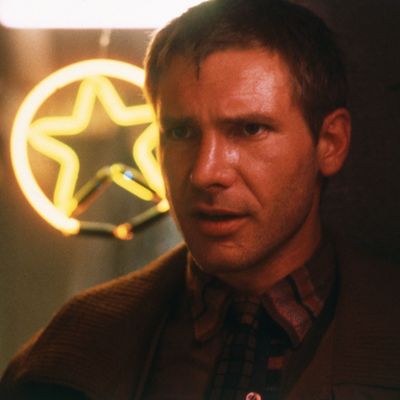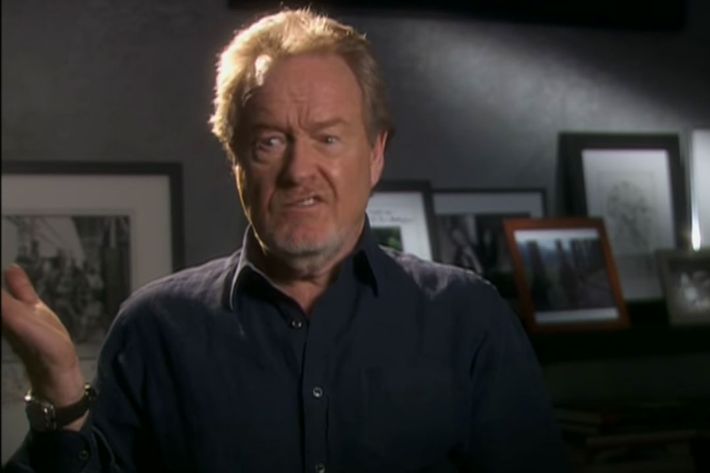
Few movies have seen as many revisions as Ridley Scott’s 1982 sci-fi cornerstone Blade Runner. Eight different cuts of the film have been completed and seen by human eyes, though a sparsely mentioned “early cut” running four hours was only screened for private studio personnel, and a sneak-preview cut shown only once in San Diego allegedly contains three scenes unseen prior to that or since. That still leaves six different iterations of what canon-determiners have determined to be an essential part of the Blade Runner canon.
Scott himself makes but a single talking-head interview appearance in All Our Variant Futures, the official and authorized documentary about the film’s complicated lineage and multiple versions. And to be quite frank, he doesn’t get why anyone gives a damn. “It’s really a great fuss about nothing,” he says, and shrugs. (This is his face as he says it.)


The fans, naturally, disagree. An obsessive subculture has sprung up around the study of and appreciation for the multiple paths of Rick Deckard’s search for ontological truth. Newcomers to the film — or those who want to brush up on their Blade Runner before the sequel, Blade Runner 2049, hits theaters on October 6 — may be at a loss when figuring out which is the definitive take. The secret, though, is that there is no secret — each one has its own merits, and it’s simply a matter of finding the right cut for you. Read on for a full assessment of each version:
If you’ve already seen the rest:
Though the workprint prototype version holds the title of the earliest publicly available cut of the film, it’s really best seen once a viewer has established a close familiarity with the others. Initially yielding a negative response when shown to test audiences prior to the theatrical releases in Denver and Dallas, the film caught fan interest upon its rerelease as a so-called “director’s cut,” over which Scott had no control whatsoever, in 1990 and 1991. Fascination with this cut stems primarily from comparison — the close analysis of minute changes made between this point A and the theatrical cut’s point B. The changes themselves are fairly minimal — an opening backstory crawl has been replaced with a definition title card, the elision of Harrison Ford’s narration — but for a movie pored over like Scripture, every tweak counts. (The international cut and the workprint prototype cut are both available on the Blade Runner Ultimate Collector’s Edition DVDs, released in 2007.)
If you crave order and justice in this chaotic, amoral world:
Ridley Scott himself considered the U.S. theatrical version to be something of a betrayal, having been spliced together by executives after postproduction without the director’s knowledge. While Scott’s own cut drew praise for its defiantly ambiguous stance on big questions both of philosophy and its own plot (is Deckard a replicant or what?), the cut released to theaters during the film’s initial run tied everything up in a big, happy bow. Using aerial shots nicked from Stanley Kubrick’s The Shining B-roll and Ford’s leftover narration, executives at Warner Bros. whipped up an ending that sees Deckard and replicant Rachel escaping Los Angeles and driving off into greener pastures. In voice-over, Deckard rather abruptly explains that Rachel’s somehow exempt from the expiration-date death sentence to which all other replicants are subject. It’s pretty bogus, but if you feel alone in a cold and indifferent world and need your last shred of optimism affirmed, by all means.
If you’re down for an eye-gouging:
Anything goes in Europe. The more libertine attitudes across the Atlantic influenced the international theatrical version, distinctive mostly for including three scenes of gratuitous violence excised from the U.S. release. Viewers with tougher stomachs may find pleasure in such gruesome flourishes as Roy Batty gouging the bejesus out of Tyrell’s bleeding eyes after their scuffle in the bedroom, Pris grabbing Deckard by the nostrils to hoist him using two fingers, and Batty giving himself a gory DIY stigmata as he approaches his final moments. Be forewarned that the quality will be poor — distributed by Criterion so long ago the only format was laser disc, it’s never gotten a proper video treatment. HBO played it once in 2015 for kicks, but getting your eyeballs on this one isn’t easy.
If you’re looking for family-friendly existential fun:
There’s a long, proud tradition of cleaning up movies for exhibition on network TV, a practice that’s given us such gems as “pick up the mickey-fickey phone” and “yippee-ki-yay, melon farmer!” The U.S. broadcast version of Blade Runner went in the opposite direction of the international edit, toning down any material the folks at standards and practices might cluck their tongues at. Out went the sexy future hookers and the profanity, and the violence was scaled way back. The result of all this scrubbing could be considered a pale imitation of the real thing, unless a parent’s looking to share their favorite Philip K. Dick adaptation with their child, unencumbered by the fear that they may traumatize the little one for life. (Better still: The TV version played bundled with an intro declaring Blade Runner’s tagline to be “Where Love Can Be the Deadliest Sin.”)
If you fancy unicorns:
The version known as the Director’s Cut is a bit of a misnomer, seeing as Scott only provided notes on the effort, leaving most of the actual work to preservationist Michael Arick. All the same, it represented the first step in restoring his original vision, because it has unicorns. Well, a unicorn. The fabled be-horned horse appears in an origami form, given to Deckard as a taunt from his nemesis Gaff. The beast figures into the film as a prominent symbol for Rachel — its rarity, beauty, and innocence tarnished by her love for Deckard. But in showing the unicorn as appearing in Deckard’s dreams before he receives the origami miniature, the director’s cut asserts that Deckard definitely is a replicant. (How else would Gaff have access to his thoughts and memories?) Most importantly, the happy ending had been excised and replaced with a cut to black that leaves Deckard and Rachel’s fates unclear.
If you’re a card-carrying auteurist:
Here’s the true director’s cut, personally assembled by Scott and released into theaters in 2007 under the moniker the Final Cut. Everything was as Scott had originally wanted it: The unicorn dream appears in its fullest and unexpurgated version, the violent scenes from the international edit have been reinserted, the picture has been fully spiffed up, and the sinuous electronic score from Greek composer Vangelis has never sounded better. This is probably the version to start with, artistically preferable to the theatrical cut and now shown in repertory theaters more widely, too. The title’s perfectly apropos, this hard-won authoritative edit being the end result of a long legal battle between studios to free up the license to Scott’s original footage. True fans will accept no substitute.
If you have a flagrant disregard for reality:
If you’re not afraid of traversing some of the internet’s more obscure alleyways, then the wild world of fan edits may acquaint you with some off-beat curios. The diehards have chopped and screwed the film every which way, wantonly color-correcting and restoring deleted scenes as suits their highly specific and seemingly arbitrary whims. (Some posts will clarify specs as minuscule as “11 seconds shaved from club scene,” etc.) Murmurs tell of a golden fan-edit standard known as the White Dragon Cut, the handiwork of a user handled “kazuchoice,” who went so far as to digitally alter the film with new effects and entirely original shots instead of merely remixing. It’s the ultimate tribute to a movie that commands cultish admiration down to some mind-bogglingly granular levels. It is, however, quite elusive. One might describe it as lost in time, like tears in rain?

